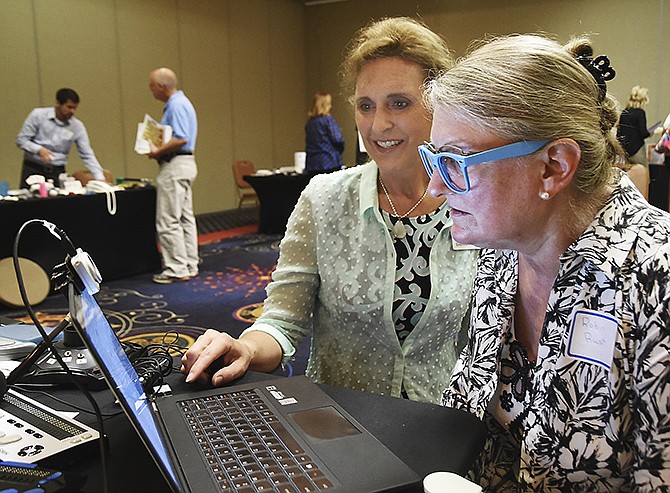Technology has become an innovative tool that continues to evolve and help people with various forms of barriers and obstacles.
Missouri Assistive Technology (MoAT) hosted its first "Demo Day" on Friday at Capitol Plaza Hotel in Jefferson City, where MoAT staff showed area residents how assistive technology can help in the office, classroom and at home.
Afternoon presentations covered iPad accessibility, standing workstations and home automation that let visitors learn and test out new and innovative technology.
Assistive technology often is used by senior citizens who have developed Alzheimer's disease, dementia and other restrictive diseases, but it also assists anyone at any age with disabilities.
MoAT has assisted Missouri residents with disabilities by connecting them to the right resources and funds, often through loans, to help with their needs so many can live independently.
Even for those who aren't able to afford the higher costs of assistive technology, MoAT tries to steer them toward the right resources, MoAT Director Marty Exline said.
Assistive technology includes anything that can help someone to overcome barriers that affect their life and to gain independence, program coordinator John Effinger said. Even something as simple as a rubber grip on a pen or pencil can be considered assistive technology.
"Our answer on how technology can help people with disabilities is to simply ask, 'What is it you want to do?'" Effinger said.
Since MoAT started in 1993, technology has continued to advance and evolve to help people's specific needs.
Technology will continue to evolve even as it becomes smaller, said program coordinator David Baker. One example he used at MoAT's "Demo Day" is the iPad.
"The iPad is a great tool for say, a kid who wants to be involved in a classroom, but has trouble communicating or reading," he said. "It's a great device that helps that kid, without screaming 'I'm different', because it blends in with what everyone else is using."
Presenting new forms of technology to large audiences for four to five hours was a great way to introduce the community to assistive technology, Exline said, but the MoAT team wondered, "What if someone only had 15 minutes to be introduced to new technology?"
That's how they came up with the idea to host "Demo Days," where residents can roam to different tables, workshops and presentations.
Tables at Friday's event showcased assistive technology from large-print computer keyboards and telephones for those visually or aurally impaired to virtual-access classrooms through FaceTime or Skype on an iPad.
For example, Double is a form of robotic telepresence using video calling and remote control for people who can't physically be in a classroom or office, but gives them the ability to communicate and move around the room.
Each table represented a program within MoAT, such as Telecommunications Access Programs (TAP) for telephone, internet and wireless, where devices can assist residents with technology that amplifies the sound of phones for the aurally impaired or enlarge text for those with poor sight.
Effinger estimated by the end of the day MoAT would see more than 200 visitors.
Brenda Whitlock, program coordinator, led the table for TAP for internet devices, showcasing iGlaze, which allows those with limited mobility function to use their eyes to type a document and browse the internet.
Exline said reaching out to the public through agencies or public events is a goal for MoAT to expand people's knowledge about how technology can help them.
He said he believes as assistive technology becomes more "mainstream," the public will even be able to learn about it at stores like Home Depot.

